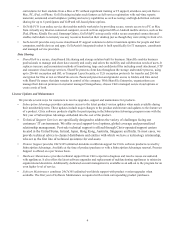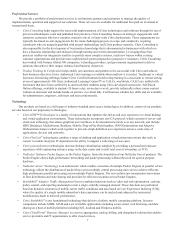Citrix 2013 Annual Report Download - page 20
Download and view the complete annual report
Please find page 20 of the 2013 Citrix annual report below. You can navigate through the pages in the report by either clicking on the pages listed below, or by using the keyword search tool below to find specific information within the annual report.16
structures which may give them a competitive advantage with our current or prospective customers. We may also see increased
competition from new types of products as the options for mobile and cloud, networking and collaboration and data sharing
solutions increase. Further, as our industry evolves and our company grows, companies with which we have strategic alliances
may become competitors in other product areas or our current competitors may enter into new strategic relationships with new
or existing competitors, all of which may further increase the competitive pressures we face. We expect to continue to face
additional competition as new participants enter our markets. As we continue to expand globally, we may see new competitors
in different geographic regions.
In order to be successful, we must attract, engage, retain and integrate key employees, and failure to do so could have an
adverse effect on our ability to manage our business.
Our success depends, in large part, on our ability to attract, engage, retain, and integrate qualified executives and other
key employees throughout all areas of our business. Identifying, developing internally or hiring externally, training and
retaining highly-skilled managerial, technical, sales and services, finance and marketing personnel are critical to our future, and
competition for experienced employees can be intense. In order to attract and retain executives and other key employees in a
competitive marketplace, we must provide a competitive compensation package, including cash- and equity-based
compensation. If we do not obtain the stockholder approval needed to continue granting equity compensation in a competitive
manner, our ability to attract, retain, and motivate executives and key employees could be weakened. Failure to successfully
hire executives and key employees or the loss of any executives and key employees could have a significant impact on our
operations. Further, changes in our management team may be disruptive to our business, and any failure to successfully
integrate key new hires or promoted employees could adversely affect our business and results of operations. Competition for
qualified personnel in our industry is intense because of the limited number of people available with the necessary technical
skills and understanding of products in our industry. The loss of services of any key personnel, the inability to retain and attract
qualified personnel in the future or delays in hiring may harm our business and results of operations.
Effective succession planning is also important to our long-term success. Failure to ensure effective transfer of knowledge
and smooth transitions involving key employees could hinder our strategic planning and execution. In January 2014, we
announced that Mark B. Templeton, our President and Chief Executive Officer, intends to retire within the next year. There are
no assurances concerning the timing or outcome of our search for a new Chief Executive Officer. Our ability to execute our
business strategies and attract and retain key executives may be adversely affected by the uncertainty associated with the
transition to a successor CEO.
Adverse changes in general global economic conditions could adversely affect our operating results.
As a globally operated company, we are subject to the risks arising from adverse changes in global economic and market
conditions. Continued economic uncertainty across all geographic locations may adversely affect sales of our products and
services and may result in longer sales cycles, slower adoption of technologies and increased price competition. Additionally, in
response to sustained economic uncertainty, many national and local governments that are current or prospective customers for
our products and services have also made, or announced plans to make, significant spending cutbacks which could reduce the
amount of government spending on IT and the potential demand for our products and services from government organizations.
Adverse economic conditions also may negatively impact our ability to obtain payment for outstanding debts owed to us by our
customers or other parties with whom we do business.
Our Desktop and Application Virtualization products are an alternative to the traditional way of managing desktops, and
various factors could cause this line of products and services to result in slower revenue growth than we have historically
experienced.
The success of our Desktop and Application Virtualization products depends in part on organizations and customers
perceiving technological and operational benefits and cost savings associated with adopting desktop and application
virtualization solutions. Although we have experienced success with this platform, some customers may experience challenges
in implementing desktop and application virtualization due to complexity as they may create complex deployments. In
addition, our primary competition in desktop and application virtualization is the existing IT practice of managing physical
desktops as devices, and the success of our Desktop and Application Virtualization products may depend on information
technology executives' continuing to rethink how desktops can be delivered more effectively and efficiently. To the extent that
there is slower adoption of desktop and application virtualization solutions, the revenue growth associated with our Desktop
and Application Virtualization products may be slower than we have historically experienced, which could adversely affect our
business, results of operations and financial condition.
We anticipate that sales of our Desktop and Application Virtualization products and related enhancements and upgrades
will constitute a majority of our revenue for the foreseeable future. Declines and variability in demand for our Desktop and
Application Virtualization products could occur as a result of:
























